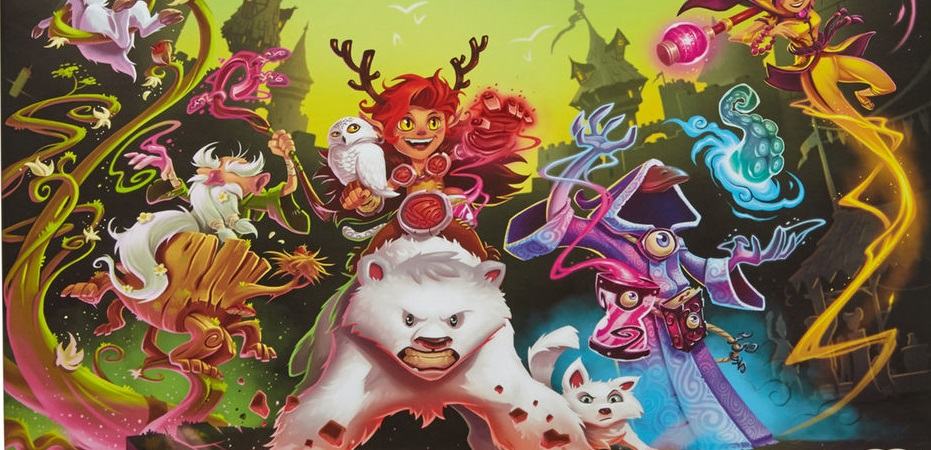Wizards Wanted’s background shines through in almost every way – from the overproduction to the low price point, to the middle-range of difficult and accessibility of the game’s rules and mechanism. It’s a unique creation that I can’t see any hobby publisher producing, and yet, despite all that, I think it’s a good thing.
This is the type of game that only a big box manufacturer could pull off, and it manages to find a hole in our hobby that I didn’t previously realize existed, and fill it. These are good things, though I can’t shake the feeling that the game itself is still…somehow, lacking.
I’ll explain.
How Wizards Wanted Plays
Wizards Wanted takes place in a candy-coated, shiny world fully of pixies, gnomes, and at times, some stereotypes. On a player’s turn, they will spend a combination of movement points, paid for with pixie dust they collect throughout the game, and move around the board. There are ways to speed up movement with a taxi, some special tokens and cards, but generally you can move about 5 spaces every turn (at the most).

The goal is to get to spaces that offer Spell Jobs. These cards cost a certain amount of dust, and they award you with a certain number of victory points, alongside a certain number of special symbols that will in some way influence end game scoring. You can also pick up special tokens that increase both the points and money earned from these cards.
There are other mechanisms.
A Spell License you need to pick up from the castle that offers end game bonuses (or penalty if you don’t get it). Token bonuses and chains, you can pick up depending on your wizard.
But mostly, it’s about getting these cards, creating sets, and amplifying your scoring opportunities.

At first glance, Wizards Wanted looks like a cross between the candy-sweet mass market fare we’re all used to at Toys R Us and the shiny, high quality artwork of our FLGS. It’s a game about wizards spending action points to move around a board and complete various cards that reward victory points.
Everything about this game is a hobby-game mechanism that goes only halfway. Sure, you’re collecting resources to turn in and score points, but it’s a single resource. There are no secondary resources here. It’s pixie dust and coins. The coins are worth points (at a half rate), and you’ll collect a few, but mostly they are used to buy the dust you need for movement.
All this works and flows smoothly, without having to worry about rounds or resetting anything, but it’s an interesting mix of too much and too little in certain ways.
What We Like About Wizards Wanted
This is a cute game with fantastic production values and a price point below $40 that is unheard of in hobby games. The gems are different shapes and plastic, the cardboard is thick and satisfying. The artwork is fantastic and highly evocative of a mystical (though somewhat generic) fantasy world.

I was smitten by the game when I first saw it, especially alongside the super-sized version that Mattel was demoing at Gen Con. It’s a very pretty game to look at and the production values are higher than you’d expect for something we’ll certainly see in the toy store shelves soon enough.
The gameplay is smooth too. There are no rounds – the game resets the board periodically when a certain number of the spell cards are taken, and the movement mechanics mean you’re never quite stuck. You can always find something to do and it works seamlessly with the game’s mechanics.

This is the kind of family game I wish had existed when I was 9 or 10 years old. It’s beautiful, just complex enough to make children feel smart, and not too simple to cause stress or discomfort from adults who are often bored by children’s games.
What We Don’t Like About Wizards Wanted
Despite all this care to detail and the specific integration of hobby quality artwork, components, and nuance in mechanisms, the game just never quite feels like a hobby game.
The rules have a few too many steps to be comfortable for the younger crowd (the box says 10+), but are often one or two dimensional, making them uninteresting for players seeking something strategic. You get lucky at times with what cards appear near you on the board. A high value card shows up right next to you when they reset? Good for you! Now you don’t have to spend valuable dust for movement.

As I said, this would have been amazing when I was 9-10 years old, but I struggle to see how it would fare with anyone outside that range. As a parent, I find its simplistic take on familiar mechanisms boring and repetitive over the course of an hour or so, and with two children at home, I can say that it doesn’t quite click at their age. In a few years maybe, but for how long?
Wizards Wanted feels like a game by committee made by the world’s largest toy maker. This is a company that sees the trends moving toward a more designer-focused game and they want in.
Don’t get me wrong – I like this game. It’s beautiful to look at (if a bit busy), easy to teach, and a nice introduction to euro-style board games, without the complexity of those games (and their gateways). But it has a very narrow audience – you may find it challenging to get this out for anyone outside of that target age range.
The Bottom Line
Wizards Wanted is a well-produced, beautiful production; similar to Hollywood’s ability to churn out entertaining, colorful action flicks summer after summer. It follows a formula, streamlines mechanisms to make them accessible to a large audience, and integrates the newest best practices of the hobby world, but it doesn’t do anything to innovate or expand the systems that we all know and love.
For this reason, it’s a great game for the non-gamer crowd, a strong entry for gamers with children 8-12, and an interesting experience for anyone who wants to see mass market reach a wider audience, but it’s not a game worth tracking down for hardcore gamers.
[amazon_link asins=’B01MXWODIH’ template=’ProductGrid’ store=’norwwrit-20′ marketplace=’US’ link_id=’e8c1a43c-9ef5-11e7-aa5a-3353073ccbfa’]


